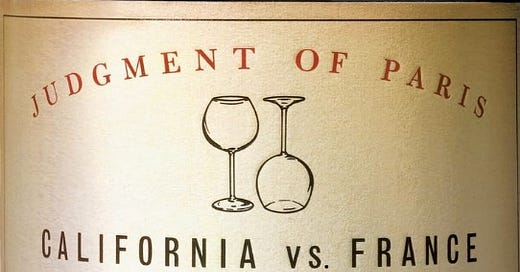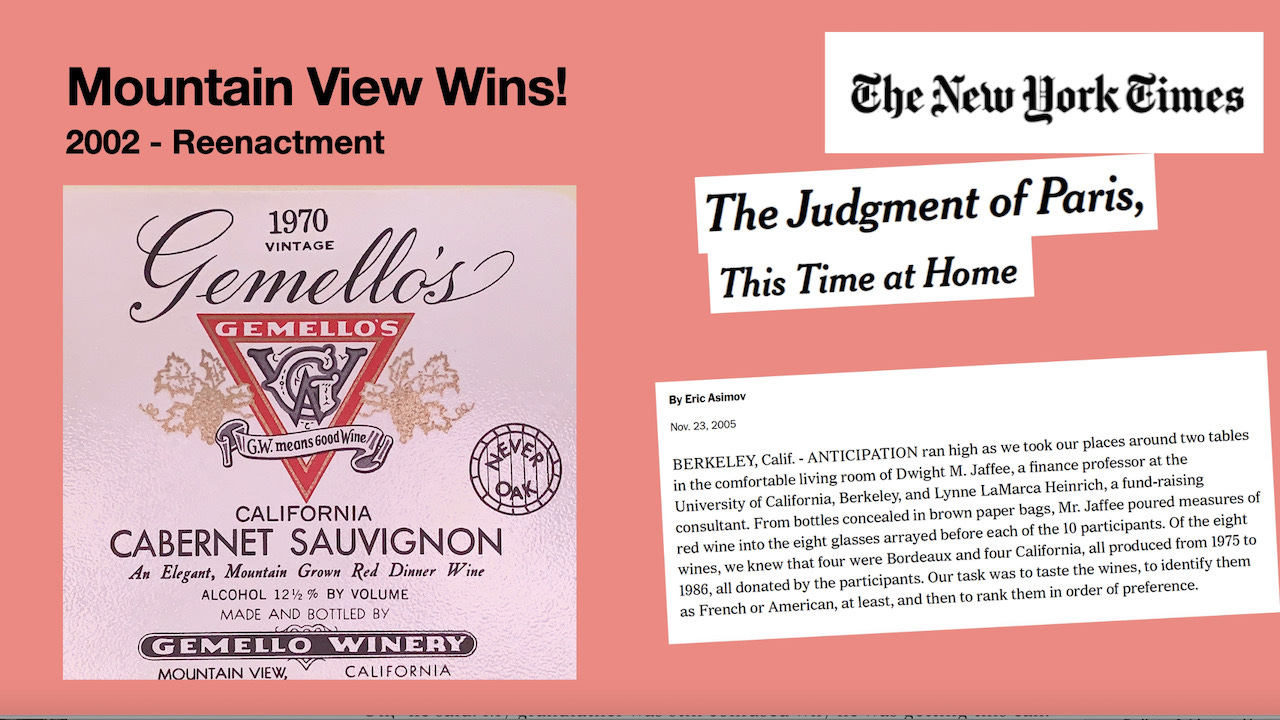The Tasting that Shocked the Wine Industry - Revisited
In a recent interview, the event organizer reveals how my grandfather’s wine became a fluke entry, before stunning top wine judges.
Welcome to a newsletter themed at the intersection of longevity and wine history. 🍷
Cover art from George Taber’s book, “Judgment of Paris,” published in 2005.
Mark Golodetz had a job in the nineties that prompted uncomfortable conversations. He was the European correspondent for Wine Enthusiast magazine. He says every time he traveled to the Bordeaux region of France, he’d hear complaints about how the French were robbed in the Paris tasting of 1976. This landmark event in which judges determined two Napa Valley wines to be superior to any of the French wines became known as The Judgment of Paris.1
British wine merchant Steven Spurrier hosted the event. When Time correspondent George Taber, the only journalist there, reported the results, it sent shockwaves through the industry.
Golodetz wasn’t there. Wine Enthusiast didn’t even exist yet. But 15 years later, as a member of the wine media, Golodetz was among those considered a target by the French to lodge their grievances.
“I heard people complaining that the Spurrier tasting didn’t choose the right French wines or vintages,” Golodetz told me in his British accent by phone recently. (Spurrier, who later was portrayed by Die Hard’s Alan Rickman in a Hollywood movie about the tasting called Bottle Shock, passed away in 2021.)
“I heard people complaining that the Spurrier tasting didn’t choose the right French wines or vintages,” Golodetz said.
Spurrier owned a wine shop in the seventies near the American and British embassies in Paris. The shop catered to the affluent Anglo-American community, running classified ads in the International Herald Tribune. The 1976 Paris tasting was promoted to honor America’s bicentennial.2 This may be a bit ironic. An Englishman hosting a special event celebrating American independence. Even more, Spurrier recruited all French judges. Nine of them.
Nearly a quarter of a century later, Golodetz had moved to New York and was president of Sleepy Hollow Wine Company. He decided to re-enact the event to mark the 25th anniversary of the Judgment in Paris. He assembled a group of wine writers, winemakers and collectors for a blind tasting in Manhattan of seven Bordeauxs and seven California Cabernets from the early ‘70s.
“I chose the best from both regions from the 1970s, wines such as Petrus 1970, La Mission 1975, Heitz Martha’s 1974 and Phelps Eisele 1975.”
Then a fluke accident caused him to include a 1970 Gemello Cabernet, made by my grandfather, Mario Gemello.
“As I was boxing up the wines in my cellar, I broke a bottle of 1974 Mondavi Reserve,” Golodetz said. He needed an alternative. “The only other bottle that fit the criteria was Gemello 1970.”
“As I was boxing up the wines in my cellar, I broke a bottle of 1974 Mondavi Reserve,” Golodetz said. He needed an alternative. “The only other bottle that fit the criteria was Gemello 1970.”
Gemello wine was from California, but not from the more prestigious wine regions of Napa or Sonoma. It was from Mountain View, the center of Silicon Valley.
Golodetz said one of his friends who was a wine broker had turned him on to wines from Gemello Winery years earlier.
“He sold me a couple of cases at $4 a bottle. Gemello became my house wine for a while,” said Golodetz. “I liked the wine and decided it would be interesting to see how it would fare against the other wines.”
So he put it up against many of the more traditional heavyweights, like Stag’s Leap, BV Private Reserve 1970, Heitz Martha’s Vineyard ’70 & ’74, Latour ’70 and 8 others.
The blind tasting was held at Eleven Madison, a swanky New York restaurant with views of Madison Square Park. Judges were instructed to identify if a wine was French or American. Rank their top five wines. Scores were then averaged, and a group favorite was revealed.
My Grandfather’s Proudest Memory
Sometime after the event, my grandfather got a phone call from Ray Isle, the managing editor of Wine & Spirits magazine.
It had been a while since the media had called him. He was about 82, and long retired from his winery after a 48 year career of making Gemello wine. He had no idea his wine was entered in the tasting.
Isle told him many of the judges were quite amazed - when revealing the winner, it was not only from California — again, but not even from the Napa Valley region.
“Oh,” he said. My grandfather was still confused why he was getting this call.
Then Isle delivered the mic drop. The winner: the 1970 Gemello Cabernet Sauvignon.
My grandfather was stunned.
It turned out, the 1970 Gemello Cabernet didn’t just win, but won decisively. It ranked first for 14 of 16 judges, and was thought to be French by all but one judge.3
One of the judges, Eric Asimov, would write in the New York Times a few years later, that the Gemello Cab was “both obscure and legendary.”
It was one of the best vintages Mario Gemello had made, perhaps only second to his 1960 Cabernet, my grandfather told Ray Isle.
“Martin Ray planted that vineyard up on Pierce Road, in Saratoga; it was right at the entrance to the old Paul Masson estate up there. It sloped around with a morning sun exposure — it was really one of the best cabernet vineyards in the area,” Mario told Isle.4
Golodetz said one of the judges from the 2001 tasting was so impressed with the Gemello Cabernet, that he wanted a bottle and was willing to spare no expense.
“I offered him a bottle [from my collection] at the same price as the highest priced bottle at the tasting: a Petrus, which sold for $1,000,” Golodetz said.
“I offered him a bottle [from my collection] at the same price as the highest priced bottle at the tasting: a Petrus, which sold for $1,000,” he said, referring to the prestigious and highly sought-after Bordeaux wine. (Why Petrus is so expensive?) “That was a massive amount of money in those days.”
Winning the re-enactment of the Judgment of Paris was a proud memory for my grandfather, who died of prostate cancer in 2005.
About two weeks before his death, I sat with him at Mountain View’s El Camino Hospital for his last round of radiation. He asked me to bring him the Wine & Spirits article. He wanted to read it one more time.
If you’re new here—hi, I’m Kevin!
I’m the author of 🍷 Rain on the Monte Bello Ridge,🍷 my forthcoming memoir about health, aging and winemaking. (Read the origin story of the book.) 🍇
The Centenarian Playbook is my newsletter, which features:
Healthy aging/longevity tips and stories from Grandma Kay’s long life.
Wine history & stories of the Gemello Winery
Ancestry & family research tips
In the 1976 Judgment of Paris blind tasting, Napa Valley’s Chateau Montelena won the white wine category, and Stag’s Leap Wine Cellars topped all reds.
Source: George M. Taber, Judgment of Paris: California vs. France and the Historic 1976 Paris Tasting That Revolutionized Wine (New York: Scribner, 2005)
Source: “Judgment in Paris - Revisited,” Connoisseurs’ Corner, by Charles Olken, Marin Independent Journal
Source: “The Greatest Wine You’ve Never Heard Of,” by Ray Isle, Wine & Sprits magazine, June 2002






That's a lovely story, thank you. Given California's relatively short wine history, surprises should not be unexpected and it's good to see them recognized.
What a heart-warming story! 🍷💙